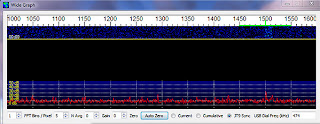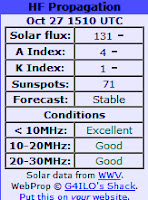 |
| DES Rotating Dipole |
A new antenna is being advertised by
InnovAntennas: a compact rotatable 15, 10 and 6m dipole with droopy ends so that the overall length is no greater than a single 10m dipole. It is called the DES-Rotating Dipole. The image on the right (from the InnovAntenna website) shows the neat arrangement which can be fed directly from 50ohms. Without lossy traps the power rating is at least 5kW, rather more than I would ever need.
Now, neat though this is, I question whether it is really worth the expense. At this stage I have no idea of price but I would expect somewhere between £50-100? My simple
Homebase-10 wire halo is MUCH smaller because the 10m dipole is arranged in a square. A 6m halo can be nested inside very easily and fed with the same coax. To add a 15m halo would only increase the size by 50%. Unlike the
Cobweb antenna, my simple design could be assembled as a 3 band version for less than £15 with all new parts.
 |
| Homebase-10 10m halo |
How much down is the halo compared with the nested dipole? In most directions, apart from a tiny segment in the direction where the ends of the halo meet, less than 2dB. What is that in S-points? Hardly noticeable at all at about 1/3 of 1 S-point.
A dipole, if rotated, does have the advantage of being able to null out interference but I am not sure this is such a benefit. For me, it is either something like a horizontal halo which tends to be a "quiet" antenna picking up little local (vertically polarised) man-made interference or a small beam which would have some gain and directivity. However, the latter will only add about 0.5-1 S-point in signal level and, time you buy a decent rotator and the beam, you will have paid 10-15 times more for the privilege. A beam does add directivity and interference rejection, but is much larger. For me it is a "no brainer". My simple little halo has allowed me to get QRP reports on SSB, CW and WSPR from all over the world. It is simple and works well.































